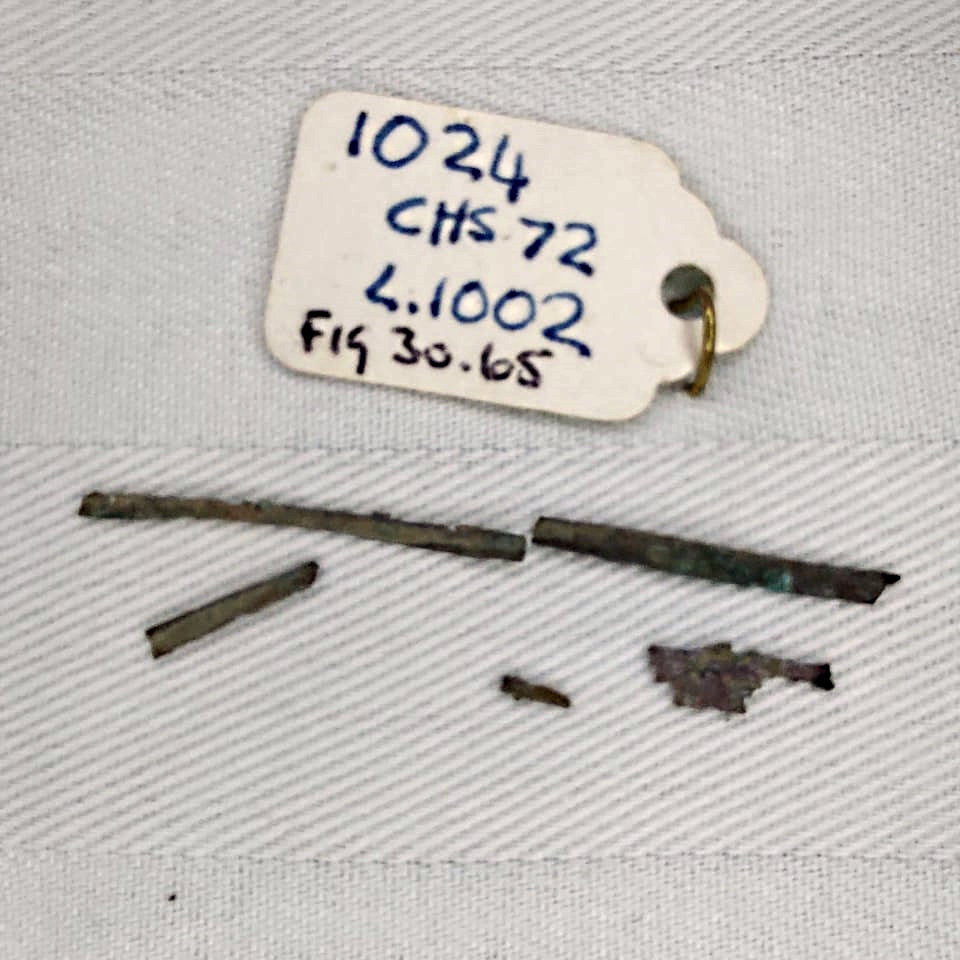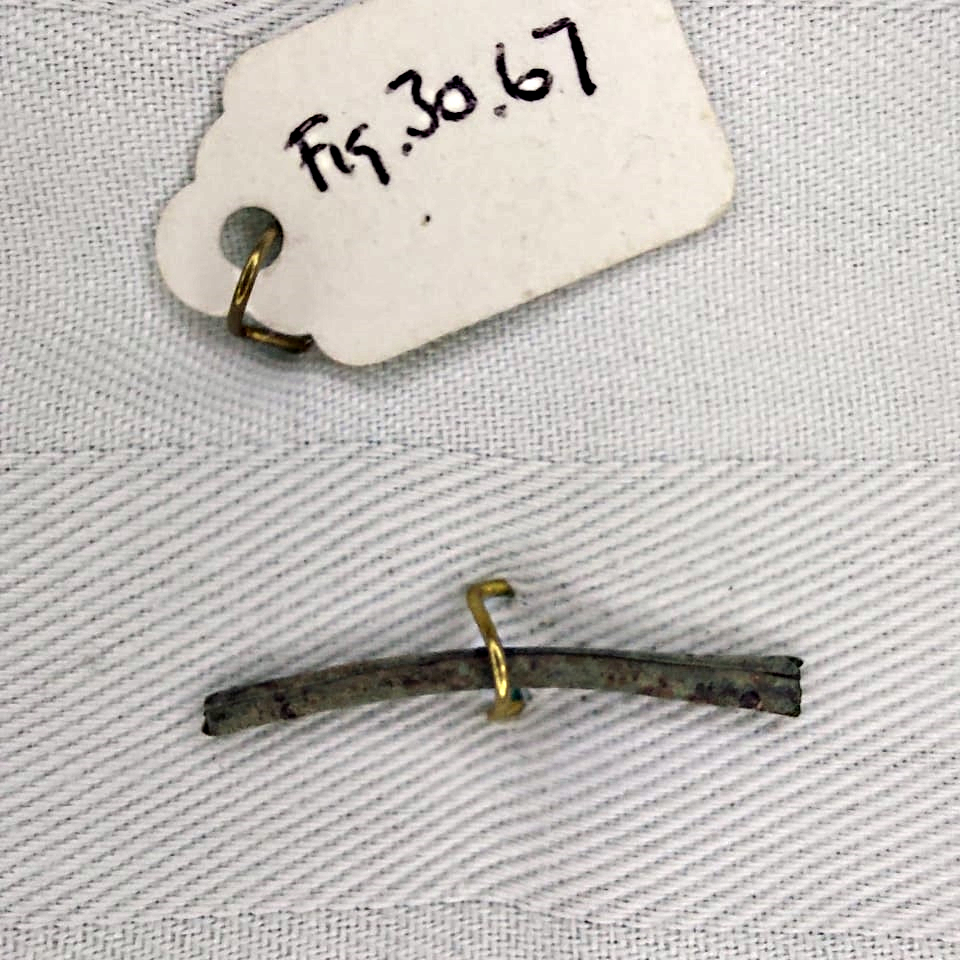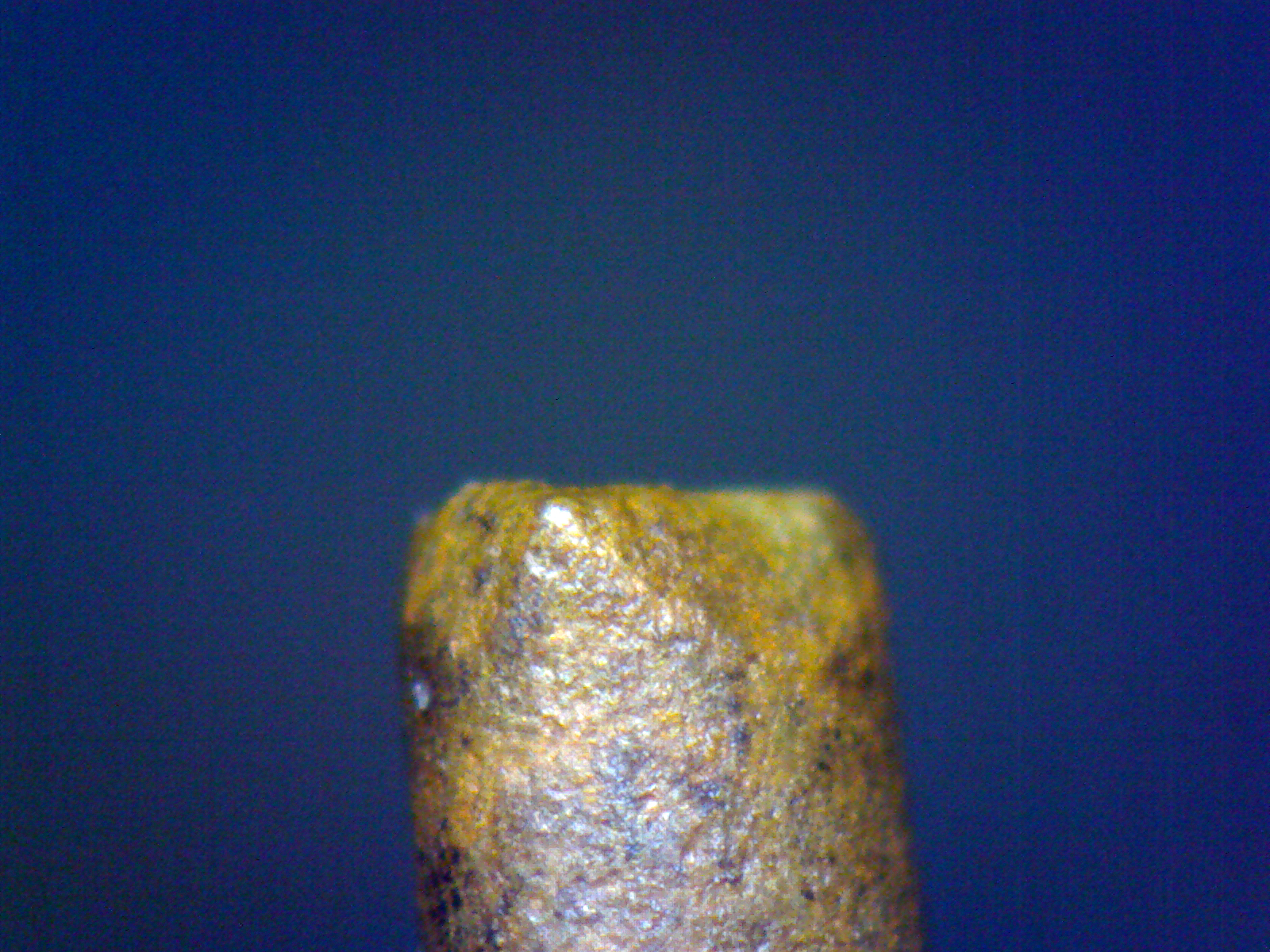Extant Aiglet Information
This page is expanding and will have a lot of information added soon. Each aiglet in my possession, extant and modern, will be listed here with images of each and discussion.
This is an ongoing project to help organize and share what I am learning. If you have any suggestions or comments, please email me at the link in the footer of the page.
Links to pages and documents
This section discusses several extant aiglets described in “Post-medieval sites and their pottery, Moulsham Street, Chelmsford”.
“Of the type 1 tags, 4 possessed a transverse groove decoration (AML no 876682) which Bayley (1985, 47) suggests may have been caused by the use of ridged pliers.”. This is notable for two reasons.
First, “Four of the type one lace tags may have been decorated with the use of "ridged pliers". Decorated, not manufactured, but this is the first suggestion pliers of any sort may have been used in the manufacturing or decoration of aiglets (lace tags). The sketch of one of the aiglets do not show the decoration in detail but do show an un-remarkable type 2 aiglet.” Second, this is the first evidence I had found type 2 aiglets were decorated. Since then, I have found several examples of type 1,2 and 3 aiglets that are decorated. A question I wanted to answer when I started my research was “were pliers were used to make aiglets”?
In “Post-medieval sites and their pottery, Moulsham Street, Chelmsford” figure 30.73, This aiglet was noted as possibly being decorated with something akin to ridged pliers. The curator was able to locate the aiglets in the illustration but was unable to take detailed images. He was gracious enough to send them to me for examination but unfortunately, they were too fragile and most of them did not survive the trip halfway around the globe. Of the 9 aiglets sent, (Fig. 30.65, 30.67 to 30.73) only 4 made the trip intact. The aiglet in Figure in 60.73, was missing entirely, probably from being lost from the damage to the package in mailing.
But, like a phoenix rising from the ashes, information became available that would not have been apparent if the aiglets had arrived intact.
Chelmsford 30.65
Number: a
Type: 2
notes:
Extant Aiglets made with pliers
The aiglet depicted in Figure 30.65 from Cunningham, C. M., & Drury, P. J. (1985), figure 30.65 had cracked down its length and had several smaller pieces break off, and some were missing, during the journey from Chelmford, UK to Wisconsin, USA. When examined, the aiglet was determined to be a Type 2 aiglet where both sides of the metal is folded into the lace to securely hold it in place. Only one side of the seam made the trip. This inner part, having been protected from polishing, wear, and corrosion, clearly shows marks left by tools during the manufacturing process.
The edge has a pattern of bends suggesting it was folded over the lace, then crimped several times along its length by a small set of needle nose pliers to tightly grip the lace before the aiglet was bent into a round shape. It is possible it may have been done with a punch but that would take longer and involve more tools.
The top of the aiglet is on the right and the seam is at the bottom of the image. I believe the image below shows enough evidence to say pliers were used during the manufacturing of type 2 aiglets. It is possible pliers were also used in the manufacturing of type 3 aiglets.

Chelmsford aiglet 30.65

Aiglet 30.65 fragment

Aiglet 30.65 fragment
Chelmsford 30.67
Number: b
Type: 1
notes:

Chelmsford aiglet 30.67
Chelmsford 30.68
Number: c
Type: 3
notes:

Chelmsford aiglet 30.68
Chelmsford 30.69
Number: d
Type: 1
notes:

Chelmsford aiglet 30.69
Chelmsford 30.70
Number: e
Type: 1
notes:
Faceting at the top of aiglets.
Faceting the tops of aiglets to secure them To cords has been suggested by others as a viable technique.
Several aiglets have had the tops filed to appear faceted. Is this a method to attach them or is it purely decorative?
It has been suggested that the faceting at the tops of aiglets was to secure them to cords. At this point I do not believe that experiments would support this hypothesis.
It is possibly a decorative detail or simply the top being poorly filed to remove any burrs that might interfere with inserting the cords into type 1 aiglets.
Sevral aiglets in my collection show this at the top. Type 1 and type 2.
This aiglet is Chelmsford #30.70. A type 1 aiglet.

Chelmsford aiglet 30.70

Chelmsford aiglet 30.70
Chelmsford 30.71
Number: f
Type: 2
notes:

Chelmsford aiglet 30.71
Chelmsford 30.72
Number: g
Type: 3
notes:

Chelmsford aiglet 30.72
Thames 1
Number: 1
Type:
notes:
Thames 2
Number: 2
Type:
notes:
Thames 3
Number: 3
Type:
notes:
Thames 4
Number: 4
Type:
notes:
Thames 5
Number: 5
Type:
notes:
Thames 6
Number: 6
Type:
notes:
Thames 7
Number: 7
Type:
notes:
Thames 8
Number: 8
Type:
notes:
Thames 9
Number: 9
Type:
notes:
Thames 10
Number: 10
Type:
notes:
Thames 11
Number: 11
Type:
notes:
Thames 12
Number: 12
Type:
notes:
Thames 13
Number: 13
Type:
notes:
Thames 14
Number: 14
Type:
notes:
Thames 15
Number: 15
Type:
notes:
Thames 16
Number: 16
Type:
notes:
Thames 17
Number: 17
Type:
notes:
Thames 18
Number: 18
Type:
notes:
Thames 19
Number: 19
Type:
notes:
Thames 20
Number: 20
Type:
notes:
Thames 21
Number: 21
Type:
notes:
Thames 22
Number: 22
Type:
notes:
Thames 23
Number: 23
Type:
notes:
Thames 24
Number: 24
Type:
notes:
Thames 25
Number: 25
Type:
notes:
Thames 26
Number: 26
Type:
notes:
Thames 27
Number: 27
Type:
notes:
Thames 28
Number: 28
Type:
notes:
Thames 29
Number: 29
Type:
notes:
Thames 30
Number: 30
Type:
notes:
Thames 31
Number: 31
Type: 3
This aiglet is in very fine condition. It is a very normal type 1 aiglet with filing at the top which gives it a faceted appearance. The part of the metal on the bottom lip of the faceted area is bent inwards towards the cord of the aiglet about 0.2mm. With the metal being filed to a thinness at the top of about 0.1mm, it will not secure the aiglet to the cord with only this method.

Aiglet Thames 31 top view 1

A better view of the faceted top.

The faceting does not go all of the way around.

Some of the faceting at the top.

A good view of the uneven top.

A view of the small end.

An enlarged view of the small end.
notes:
The following comment was made by a fellow metalsmith when discussing the faceting on the tops of aiglets. “I see what you mean by faceted and that they are filed too thin to have any strength to act as a gripping method to hold onto the fiber. Most likely filed quickly and with little care since they are made quickly.”[3]
With these better images of the faceting at the top of this aiglet, I suspect that this was not done to add faceting to the top as a deliberate stylistic choice or to help secure the aiglet to a cord. I believe it was an attempt to even out the top to remove the corner of the metal that could catch and cut the threads around eyelets.
it is not possible to determine at this time if this aiglet was filed or had been rubbed on an abrasive stone.
Further, as this was riveted, I think that also suggests that this was not a stylistic decision.
The bottom was either filed or rubbed on an abrasive stone to even out the end. While not how I finish the ends of aiglets (I file the end while turning the aiglet to put an even bezel on the end. ), I do believe this provided much of the same result.
Historic Enterprises
Number: 32
Type:
notes:
T. Lazcano (1)
Number: 33
Type:
notes:
T. Lazcano (2)
Number: 34
Type:
notes:
Aluminum (India)
Number: 35
Type:
notes:
Netherlands 32
Number: 36
Type:
notes:
Netherlands 33
Number: 37
Type:
notes:
Netherlands 34
Number: 38
Type:
notes:
Netherlands 35
Number: 39
Type:
notes:
Netherlands 36
Number: 40
Type:
notes:
Netherlands 37
Number: 41
Type:
notes:
Netherlands 38
Number: 42
Type:
notes:
Netherlands 39
Number: 43
Type:
notes:
Netherlands 40
Number: 44
Type:
notes:
Netherlands 41
Number: 45
Type:
notes:
Netherlands 42
Number: 46
Type:
notes:
Netherlands 43
Number: 47
Type:
notes:
Netherlands 44
Number: 48
Type:
notes:
Netherlands 45
Number: 49
Type:
notes:
Netherlands 46
Number: 50
Type:
notes:
Netherlands 47
Number: 51
Type:
notes:
vegetative and geometric patterns
Number: 59
Type: 1
notes: 'Vegetative and Geometric Patterns' 59
Possibly Victorian. It is heavily decorated. The design and how the backside appears makes me think this was stamped out in one piece on a press of some sort making it a modern aiglet. Late 19th century.
Copper alloy
Total Length 49.96mm
Top diameter max 7.76mm
Top diameter min 6.9mm
Bottom diameter max 2.12mm
Bottom diameter min 1.86mm
metal thickness in MM 0.26
You can see from the inside edge that this was stamped out using a press. I feel safe dating this as a modern aiglet. the date is very broad as it could be late 19th to mid 20th century. As this is a modern aiglet, I suspect the alloy matches closely to modern brass. Testing would be required to determine this.

You can see from the inside edge that this was stamped out using a press. I feel safe dating this as a modern aiglet. the date is very broad as it could be late 19th to mid 20th century.

a different view of the top

A close view of the top

A close view of the bottom

a side view
Nieuwlande and Reimerswaal 1
Number:
Type:
notes:
.jpg)
Nieuwlande and Reimerswaal 1
.jpg)
Nieuwlande and Reimerswaal 1
.jpg)
Nieuwlande and Reimerswaal 1
.jpg)
Nieuwlande and Reimerswaal 1
Nieuwlande and Reimerswaal 2
Number:
Type:
notes:
.jpg)
Nieuwlande and Reimerswaal 2
.jpg)
Nieuwlande and Reimerswaal 2
.jpg)
Nieuwlande and Reimerswaal 2
.jpg)
Nieuwlande and Reimerswaal 2
Nieuwlande and Reimerswaal 3
Number:
Type:
notes:
.jpg)
Nieuwlande and Reimerswaal 3
.jpg)
Nieuwlande and Reimerswaal 3
.jpg)
Nieuwlande and Reimerswaal 3
.jpg)
Nieuwlande and Reimerswaal 3
.jpg)
Nieuwlande and Reimerswaal 3
Nieuwlande and Reimerswaal 4
Number:
Type:
notes:
.jpg)
Nieuwlande and Reimerswaal 4
Nieuwlande and Reimerswaal 5
Number:
Type:
notes:
.jpg)
Nieuwlande and Reimerswaal 5
Nieuwlande and Reimerswaal 6
Number:
Type:
notes:
.jpg)
Nieuwlande and Reimerswaal 6
Netherlands 48
Number:
Type:
notes:
references
-
- ^(Messenger. (n.d.). Retrieved June 11, 2017, From FaceBook Messenger conversation with Georgia Panaritis. Montréal, Canada.)






















.jpg)
.jpg)
.jpg)
.jpg)
.jpg)
.jpg)
.jpg)
.jpg)
.jpg)
.jpg)
.jpg)
.jpg)
.jpg)
.jpg)
.jpg)
.jpg)